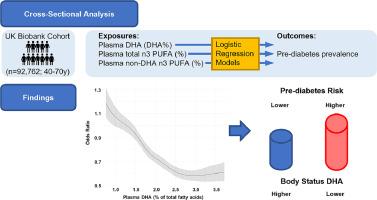血液中较高的二十二碳六烯酸比例与糖尿病前期的发病率成反比:来自英国生物库的证据。
IF 3.4
3区 医学
Q2 NUTRITION & DIETETICS
引用次数: 0
摘要
糖尿病前期和 2 型糖尿病是全球日益关注的健康问题,容易导致各种血管并发症。包括饮食干预在内的生活方式调整为预防和管理提供了前景广阔的途径。利用多变量调整模型,我们分析了英国生物库队列样本中血浆中欧米伽-3 多不饱和脂肪酸(n3 PUFA,包括总 n3 PUFA、二十二碳六烯酸 [DHA]、非 DHA n3 PUFA)的比例(占总脂肪酸的百分比)与糖化血红蛋白 A1c (HbA1c) 以及糖尿病前期患病率之间的横断面关联。我们的假设是,n3 PUFA(尤其是 DHA)的比例与糖尿病前期患病率成反比。样本(n = 92,762; 54.5% 为女性)的平均年龄为 56 岁,体重超重(平均体重指数 = 27)。样本血浆中 DHA 的平均比例为 2.03%(标准差 [SD] = 0.67%),非 DHA n3 PUFA 为 2.41%(标准差 = 1.02%),n3 PUFA 总量为 4.43%(标准差 = 1.56%)。根据美国糖尿病协会的标准,血 HbA1c 的比例在 5.7% 和 6.4% 之间(39-46 mmol/mol),即可确定为糖尿病前期患者。三种 n3 PUFA 生物标记物中的每一种都与 HbA1c 比例成反比关系。其中,DHA 的反相关性最强,在完全调整模型中将五分位数 5 与 1 进行比较,其 OR 值为 0.62(95% 置信区间:0.58,0.67;P < .001)。这些研究结果表明,n3 PUFA(尤其是 DHA)在降低糖尿病前期风险方面具有潜在的保护作用。我们需要进一步开展前瞻性研究,以明确长链 n3 PUFA 是否可作为糖尿病前期的可调节因素。本文章由计算机程序翻译,如有差异,请以英文原文为准。

Higher docosahexaenoic acid proportions in blood are inversely associated with the prevalence of prediabetes: Evidence from the UK Biobank
Prediabetes and type 2 diabetes mellitus are growing global health concerns, predisposing individuals to various vascular complications. Lifestyle modifications, including dietary interventions, offer promising avenues for prevention and management. Using a multivariable-adjusted model, we analyzed the cross-sectional associations between plasma proportions (% of total fatty acids) of omega-3 polyunsaturated fatty acids (n3 PUFA, including total n3 PUFA, docosahexaenoic acid [DHA], non-DHA n3 PUFA), and glycated hemoglobin A1c (HbA1c) as well as the prevalence of prediabetes in a sample from the UK Biobank cohort. Our hypothesis was that proportions of n3 PUFA, especially DHA, would by inversely associated with the prediabetes prevalence. The sample (n = 92,762; 54.5% females) had an average age of 56 years and was overweight (mean body mass index = 27). The mean plasma DHA proportion in the sample was 2.03% (standard deviation [SD] = 0.67%), non-DHA n3 PUFA was 2.41% (SD = 1.02%) and total n3 PUFA was 4.43% (SD = 1.56%). Prediabetic individuals were identified by blood HbA1c proportions between 5.7% and 6.4% (39-46 mmol/mol) according to American Diabetes Association criteria. Each of the three n3 PUFA biomarkers was inversely associated with HbA1c proportions. In particular, DHA showed the strongest inverse association, with an OR of 0.62 (95% confidence intervals: 0.58, 0.67; P < .001) when comparing quintiles 5 to 1 in a fully adjusted model. These findings suggest a potential protective role of n3 PUFA, particularly DHA, in mitigating the risk of having prediabetes. Further prospective investigations are needed to clarify whether long-chain n3 PUFA could function as modifiable factors for prediabetes.
求助全文
通过发布文献求助,成功后即可免费获取论文全文。
去求助
来源期刊

Nutrition Research
医学-营养学
CiteScore
7.60
自引率
2.20%
发文量
107
审稿时长
58 days
期刊介绍:
Nutrition Research publishes original research articles, communications, and reviews on basic and applied nutrition. The mission of Nutrition Research is to serve as the journal for global communication of nutrition and life sciences research on diet and health. The field of nutrition sciences includes, but is not limited to, the study of nutrients during growth, reproduction, aging, health, and disease.
Articles covering basic and applied research on all aspects of nutrition sciences are encouraged, including: nutritional biochemistry and metabolism; metabolomics, nutrient gene interactions; nutrient requirements for health; nutrition and disease; digestion and absorption; nutritional anthropology; epidemiology; the influence of socioeconomic and cultural factors on nutrition of the individual and the community; the impact of nutrient intake on disease response and behavior; the consequences of nutritional deficiency on growth and development, endocrine and nervous systems, and immunity; nutrition and gut microbiota; food intolerance and allergy; nutrient drug interactions; nutrition and aging; nutrition and cancer; obesity; diabetes; and intervention programs.
 求助内容:
求助内容: 应助结果提醒方式:
应助结果提醒方式:


